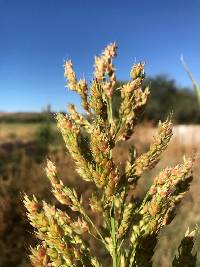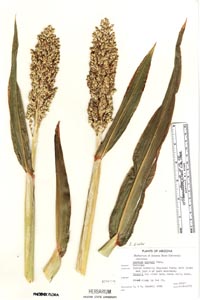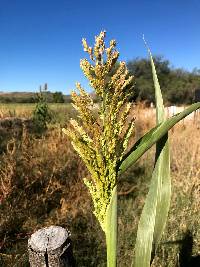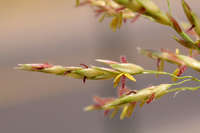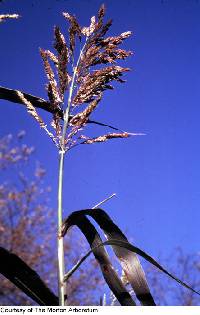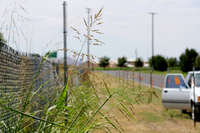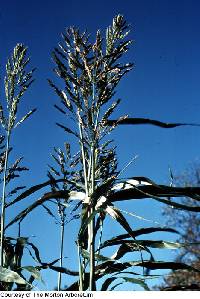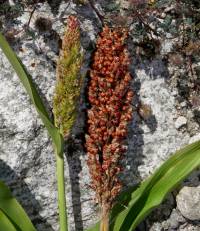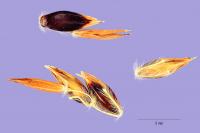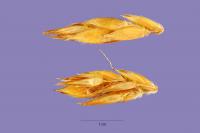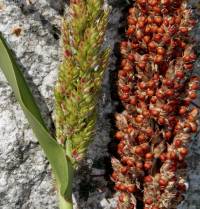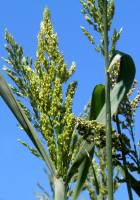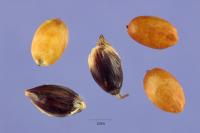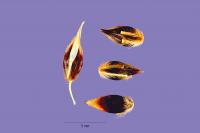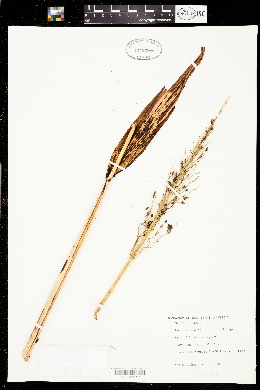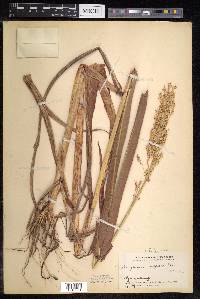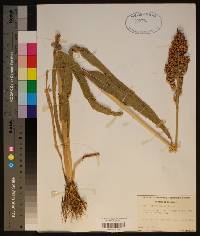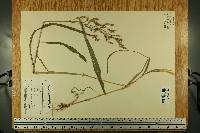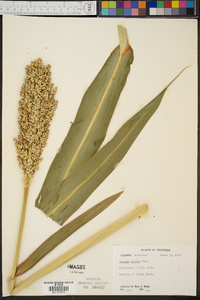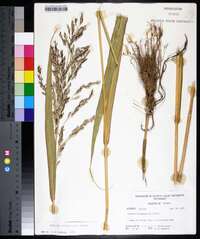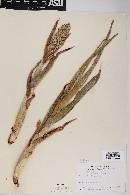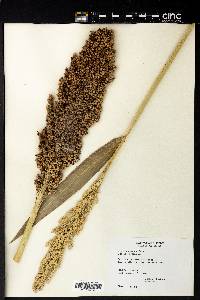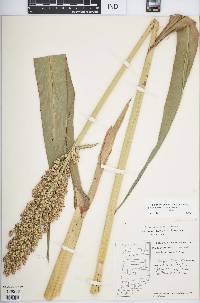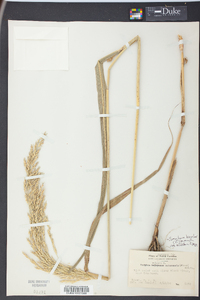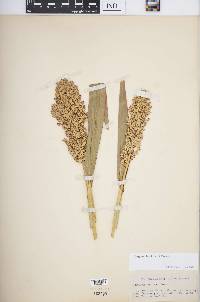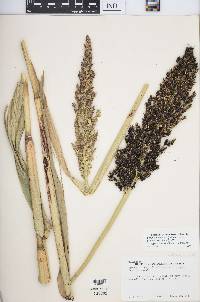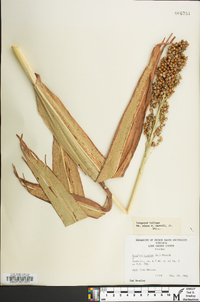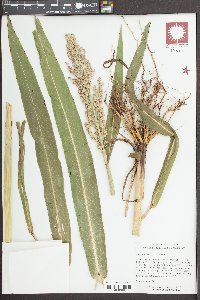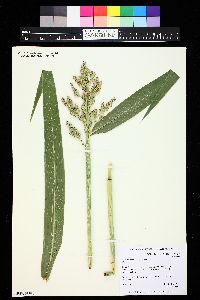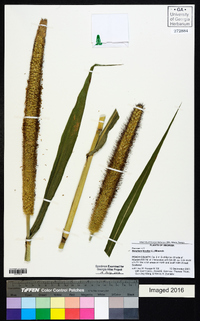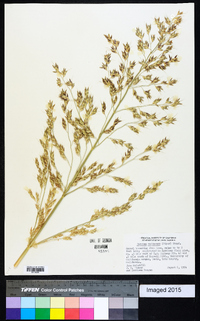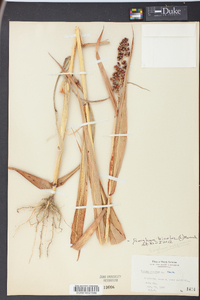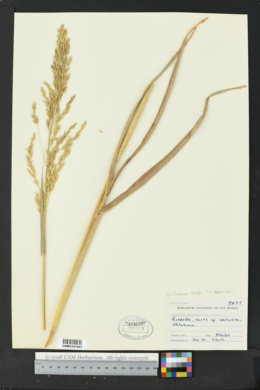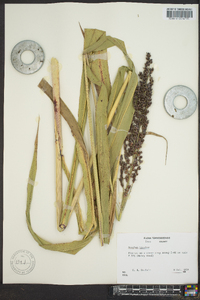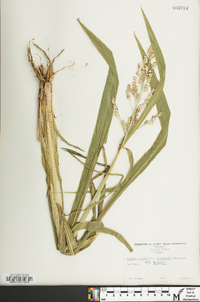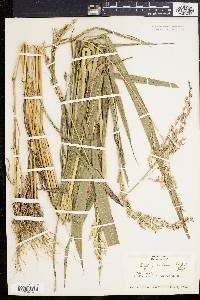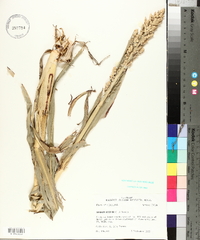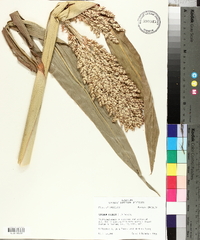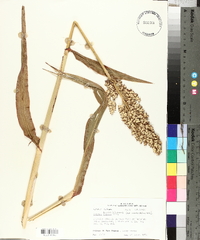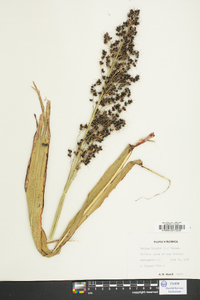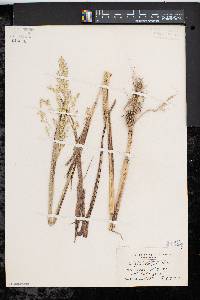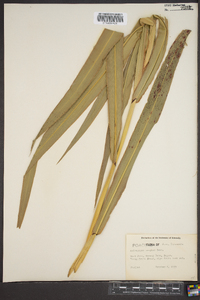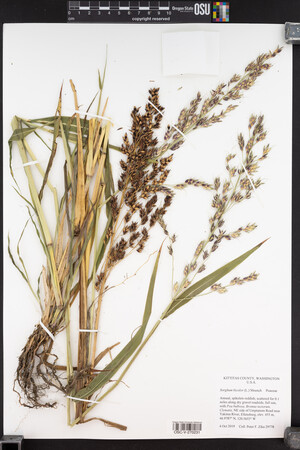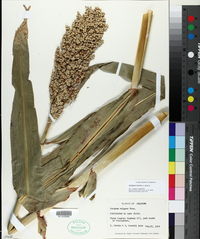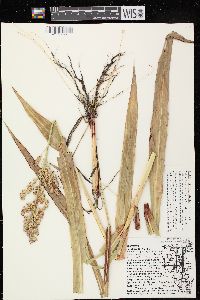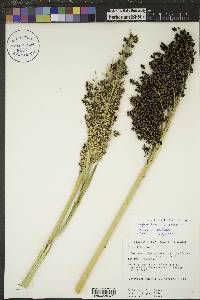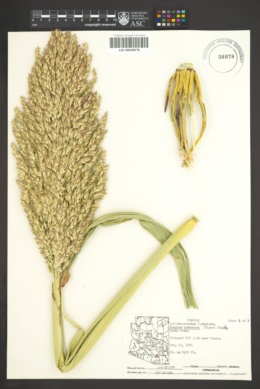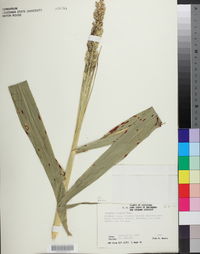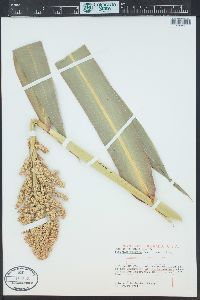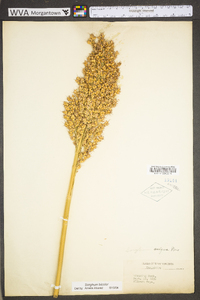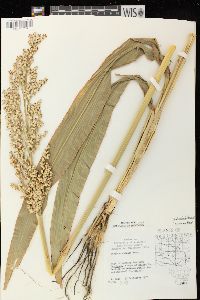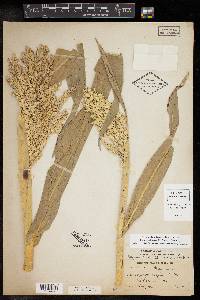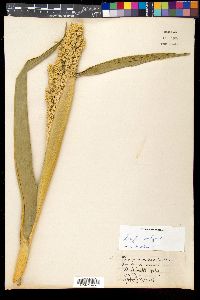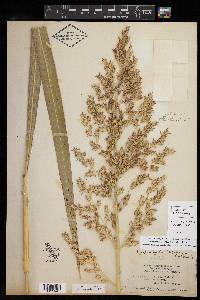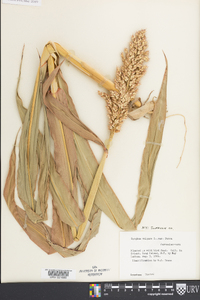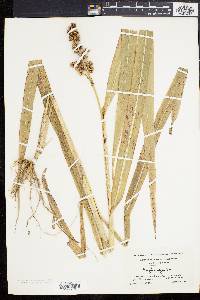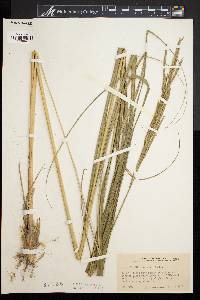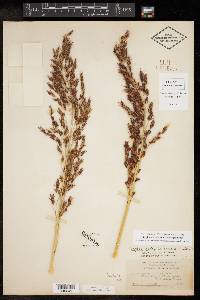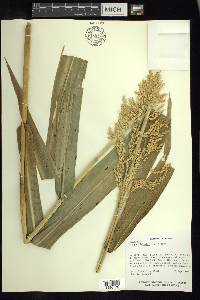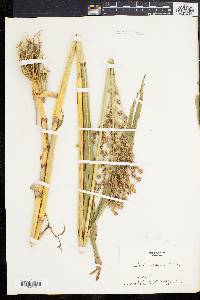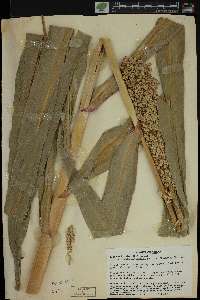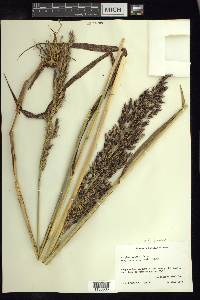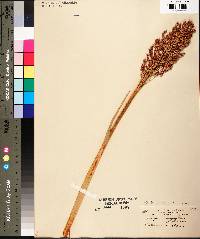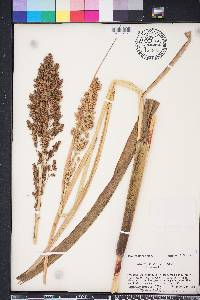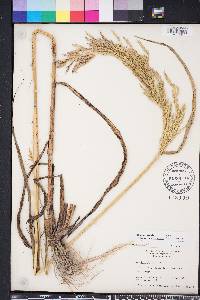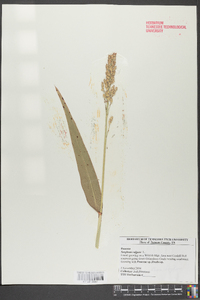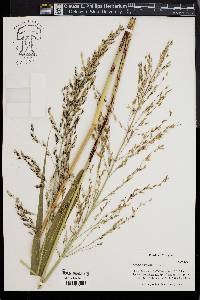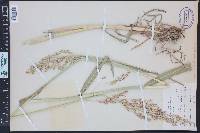Sorghum bicolor
|
|
|
|
Family: Poaceae
Broom-Corn, more...sorghum, black amber, broomcorn, chicken corn, shatter cane, shattercane, wild cane (es: sorgo)
[Andropogon bicolor (L.) Roxb., moreAndropogon caffrorum (Thunb.) Kunth, Andropogon saccharatus (L.) Raspail, Andropogon sorghum , Andropogon sorghum var. albofuscus Körn., Andropogon sorghum var. ankolib Hack., Andropogon sorghum var. bicarinatus Hack., Andropogon sorghum var. bicolor (L.) Hack., Andropogon sorghum var. caudatus Hack., Andropogon sorghum var. cernuus (Ard.) Körn. & F.A. Werner, Andropogon sorghum var. densissimus Busse & Pilg., Andropogon sorghum var. dochna (Forssk.) C. Chr., Andropogon sorghum var. durra (Forssk.) Hack., Andropogon sorghum var. hians Stapf, Andropogon sorghum var. jucundus Busse & Pilg., Andropogon sorghum var. nervosus (Besser ex Schult.) Hack., Andropogon sorghum var. roxburghii Hack., Andropogon sorghum var. saccharatus (L.) Alef., Andropogon sorghum var. sativus Hack., Andropogon sorghum var. subglobosus Hack., Andropogon sorghum var. submuticus Hack., Andropogon sorghum var. technicus Körn., Andropogon sorghum var. vulgaris (Pers.) Hack., Andropogon sorghum var. ziegleri Busse & Pilg., Holcus caffrorum Thunb., Holcus cernuus Ard., Holcus dochna Forssk., Holcus durra Forssk., Holcus niger Ard., Holcus saccharatus L., Holcus saccharatus var. technicus (Körn.) Farw., Holcus sorghum var. caffrorum (Thunb.) L.H. Bailey, Holcus sorghum var. durra (Forssk.) Bailey, Holcus sorghum var. saccharatus (L.) L.H. Bailey, Holcus sorghum var. technicus (Körn.) L.H. Bailey, Milium bicolor (L.) Cav., Milium nigricans Ruiz & Pav., Panicum caffrorum Retz., Panicum sacchariferum (L.) Salisb., Sorghum ankolib (Hack.) Stapf, Sorghum basutorum Snowden, Sorghum bicolor var. cernuum (Ard.) Ghisa, Sorghum bicolor var. saccharatum (L.) Mohlenbr., Sorghum bicolor var. technicum , Sorghum caffrorum var. albofuscum (Körn.) Snowden, Sorghum caffrorum var. bicarinatum (Hack.) Snowden, Sorghum caudatum var. angolense (Rendle) Stapf, Sorghum conspicuum Snowden, Sorghum coriaceum Snowden, Sorghum dochna var. dochna (Forssk.) Snowden, Sorghum dulcicaule Snowden, Sorghum dura Griseb., Sorghum exsertum Snowden, Sorghum gambicum Snowden, Sorghum guineense Stapf, Sorghum halepense var. saccharatum (L.) Goiran, Sorghum japonicum (Hack.) Roshev., Sorghum margaritiferum Stapf, Sorghum mellitum Snowden, Sorghum membranaceum Chiov., Sorghum nervosum Besser ex Schultes, Sorghum nigricans (Ruiz & Pav.) Snowden, Sorghum nigricans var. angolense (Rendle) Snowden, Sorghum notabile Snowden, Sorghum rigidum Snowden, Sorghum roxburghii Stapf, Sorghum roxburghii var. hians (Stapf) Stapf, Sorghum saccharatum var. bicolor (L.) Kerguélen, Sorghum saccharatum var. technicum (Körn.) Doronina & Ivanjuk., Sorghum saccharatum var. vulgare (Pers.) Kuntze, Sorghum simulans Snowden, Sorghum sorghum (L.) H. Karst., Sorghum technicum (Körn.) Batt. & Trab., Sorghum vulgare var. angolense Rendle, Sorghum vulgare var. bicolor (L.) Eaton & Wright, Sorghum vulgare var. cernuum (Ard.) Fiori & Paol., Sorghum vulgare var. nervosum (Besser ex Schult.) Forbes & Hemsley, Sorghum vulgare var. nigricans (Ruiz & Pav.) A.F. Hill, Sorghum vulgare var. vulgare Pers.] |
Plants annual or short-lived perennials; often tillering, without rhizomes. Culms 50-500+ cm tall, 1-5 cm thick, sometimes branching above the base; nodes glabrous or appressed pubescent; internodes glabrous. Ligules 1-4 mm; blades 5-100 cm long, 5-100 mm wide, sometimes glabrous. Panicles 5-60 cm long, 3-30 cm wide, open or contracted, primary branches compound, terminating in rames with 2-7 spikelet pairs; disarticulation usually not occurring or tardy. Sessile spikelets bisexual, 3-9 mm, lanceolate to ovate; calluses blunt; glumes coriaceous to membranous, glabrous, densely hirsute, or pubescent, keels usually winged; upper lemmas unawned or with a geniculate, twisted, 5-30 mm awn; anthers 2-2.8 mm. Pedicels 1-2.6 mm. Pedicellate spikelets 3-6 mm, usually shorter than the sessile spikelets, staminate or sterile. Caryopses often exposed at maturity. 2n = 20, 40. Sorghum bicolor was domesticated in Africa 3000 years ago, reached northwestern India before 2500 B.C., and became an important crop in China after the Mongolian conquest. It was introduced to the Western Hemisphere in the early sixteenth century, and is now an important crop in the United States and Mexico. Numerous cultivated strains exist, some of which have been formally named. They are all interfertile with each other and with other wild species of Sorghum. The treatment presented here is based on de Wet (1978) and is somewhat artificial. Sorghum bicolor subsp. arundinaceum is the wild progenitor of the cultivated strains, all of which are treated as S. bicolor subsp. bicolor. These strains tend to lose their distinguishing characteristics if left to themselves. They will also hybridize with subsp. arundinaceum, and these hybrids can backcross to either parent, resulting in plants that may strongly resemble one parent while having some characteristics of the other. All such hybrids and backcrosses are treated here as S. bicolor subsp. drummondii. Annual or short-lived perennial herb, often bearing side shoots 0.5 - 5.6 m tall Leaves: basal and along culm, with 1 - 4 mm long ligules and sometimes hairless blades 5 cm - 1 m long and 5 mm - 10 cm wide. Inflorescence: terminal, branched (panicle), 5 cm - 0.6 m long, 3 - 30 cm wide. The primary branches are whorled and end in spikes with two to seven pairs of spikelets. Fruit: a caryopsis that is usually exposed when mature. Culm: 0.5 - 5 m long, 1 - 5 cm across, sometimes branched, with hairless or appressed-hairy nodes and hairless internodes. Spikelets: either stalkless or stalked. The stalkless spikelets are bisexual, 3 - 9 mm long, lance-shaped to egg-shaped, and compressed on the back. Stalked spikelets male or sterile, well-developed, 3 - 6 mm long. Glumes: leather-like to membranous, hairless or hairy, sometimes densely stiff-haired, with two longitudinal ridges that are usually winged. Florets: borne on stalkless spikelets have lower florets reduced to transparent lemmas, upper florets with anthers 2 - 2.8 mm long and lemmas that are unawned or have a bent and twisted awn 5 - 30 mm long. Similar species: Sorghum halepense is a perennial that bears rhizomes and has caryopses that are not exposed when mature. Sorghum bicolor ssp. bicolor differs from other subspecies because it has exposed caryopses and inflorescence branches that remain intact at maturity. Flowering: mid September to mid October Habitat and ecology: Introduced from Eurasia, this species is frequent along railroads and grain elevators and local near bird feeders or other areas with spilled seed. Occurence in the Chicago region: non-native Notes: This species was first cultivated in Africa 5,000 years ago and has become an important crop around the world. Etymology: Sorghum comes from the plant's Italian name, sorgo. Bicolor means "of two colors." Author: The Morton Arboretum FNA 2007, Gould 1980 Common Name: sorghum Duration: Annual Nativity: Non-Native Lifeform: Graminoid General: Robust annual, stems 1-3 m tall. Vegetative: Sheaths glabrous, ligules membranous 1.5-5.5 mm long; blades flat, 20-40 mm broad. Inflorescence: Panicles 10-25 cm long, dense and compact, pedicel of the spikelet 0.5-2 mm long with hairs 0.5-1 mm long; spikelet usually sterile, rarely staminate, usually shorter than sessile spikelet, 3.5-5 mm long, narrow-lanceolate; glumes subequal, first 9-11 nerved, flat to sulcate on back, clasping second glume, second glume narrow, 3-nerved, appressed-hirsute near margins; sessile spikelet spreads apart at maturity. Ecology: Found in cultivation and rarely escaped from cultivation. Notes: The size of the seeds is one indicator, but another is the reddish tinge found on S. halepense. Two subspecies, one being the base species of all cultivated sorghums (ssp. bicolor), while the other being more specifically that of sudangrass (ssp. drummondii). Sudangrass is typically used as a cover crop and has slightly reddish caryopsis, while being slightly smaller than other sorghums. Ethnobotany: Unknown Etymology: Sorghum is from Italian sorgo, for a tall cereal grass, bicolor means two-colored, often the case of the caryopsis. Synonyms: Sorghum quineense, S. nervosum Editor: SBuckley, 2010 Coarse, maize-like annual with broad lvs mostly (2-)3-5 cm wide; panicle 1.5-5 dm, its main axis usually ±hairy; pedicellate spikelet mostly shorter than the sessile one, which is spread open by the very turgid grain at maturity; 2n=20. Originally African, now widely cult. in numerous and diverse cultivars. Three interfertile vars. are recognized. Cult. plants with large grains and usually dense, non-disarticulating inflorescences are var. bicolor. Weedy and tall shattercanes and Sudan-grass are var. drummondii (Nees) Mohlenbr. They often occur in sorghum-fields, mature early, and have fragile racemes that readily fragment. The native wild African plants, which form a third var., are ancestors of the cultivars. Gleason, Henry A. & Cronquist, Arthur J. 1991. Manual of vascular plants of northeastern United States and adjacent Canada. lxxv + 910 pp. ©The New York Botanical Garden. All rights reserved. Used by permission. |
|
|
|


